Application of Polymeric Membrane in Water Desalination
Membrane processes are among the common methods for water sweetening and desalination, however, due to the cost and energy consumption, membrane processes are more suitable and have more practical applications. Designing of membranes in different shapes and dimensions, performing of separation process at room temperature, minimum consumption of chemical materials including solvents, and other additives are among the advantages of membrane process in respect to classical and common separation processes. Different membrane processes are used for water sweetening including reverse osmosis, electrodialysis, microfiltration, ultrafiltration, and nanofiltration membrane processes in which the reverse osmosis and electrodialysis methods are more important. Polymers are commonly used as membranes for the water sweetening industry, and due to their versatile structures and properties have a specific position in such a way that their applications are growing steadily. The most suitable and efficient polymeric membranes applied in the country are cellulose acetate, polyamide composite membranes, polysulfone, polyethylene, polypropylene, polycarbonate, polytetrafluoroethylene, polyvinylidene fluoride, and polydimethylsiloxane. There are different methods for improving the efficiency of polymeric membranes in the water desalination process in which preparation of copolymers and polymer blends, chemical modifications on the polymeric structure or their chemical functionalization, preparation of composites, and physical or chemical modifications on the surface of some polymers are more important that should be resulted in a suitable collection of physical, hydrophobic, chemical, thermal, and hydrolytic stability of the polymer and also led to remarkable flux and salt rejection. In this article, different membrane processes, and polymers that are applying in this industry is briefly introduced.
- حق عضویت دریافتی صرف حمایت از نشریات عضو و نگهداری، تکمیل و توسعه مگیران میشود.
- پرداخت حق اشتراک و دانلود مقالات اجازه بازنشر آن در سایر رسانههای چاپی و دیجیتال را به کاربر نمیدهد.


